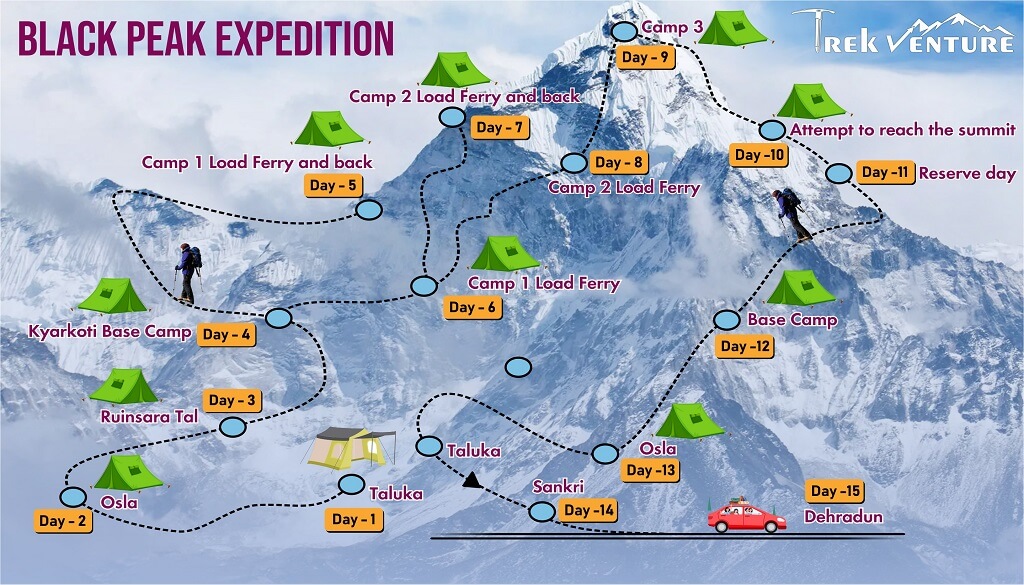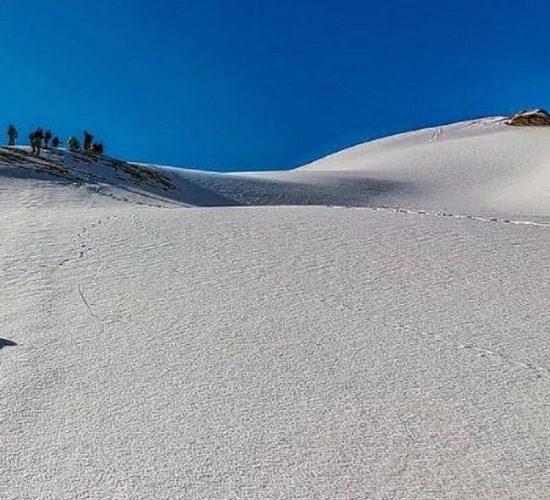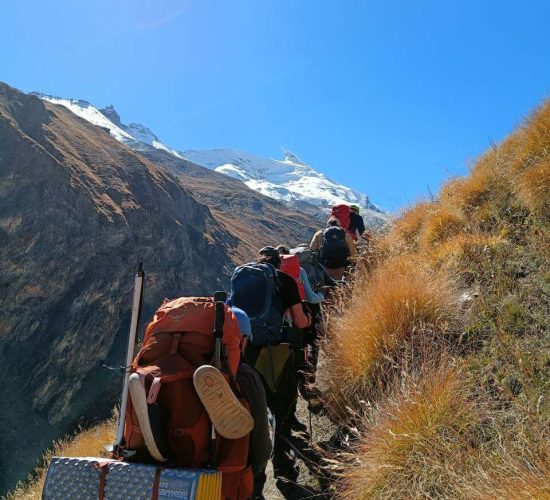Black Peak Expedition
15D – 14N | Dehradun to Dehradun
Enquire for Group Booking
↬ Description
- Altitude : 20960 ft.
- Duration: 15 Days
- Trek Length: 98kms
- Base Camp: Osla
Black Peak, the tallest peak in the Garhwal Himalayas’ Saraswati Range, is located in the valley of the same name. The locals give it the name Kalanag because the peak’s summit looks so much like a black cobra’s head. Its height of 6,287 metres is quite breathtaking. White summit or Bandarpunch II is the highest summit in the Bandarpunch massif, which also includes Banderpunch I at 6,316 m and Kalanag (Black Peak) at 6,287 m. As the highest point in the Bandarpunch massif, Black Peak is at the top of every mountaineer’s list due to its intimidating appearance and the difficulty of the ascent to the summit. Black Peak is located in a stunning area, with some of the world’s most revered mountains close by. Along the way, you’ll be accompanied by some of the most impressive mountains in the world, including the Swargarohini, Bhagirathi Massif, Bandarpunch, and Gangotri range. The path itself has unrivalled beauty over a variety of landscapes, from alpine meadows to pine woods to moraine ridges, boulders, and glacial basins, thanks to its passage through Govind National Park, renowned for its unique flora and wildlife.
↬ Itinerary
Day 1: Drive from Dehradun to Taluka
You can reach Taluka by travelling there from the train station or the bus station (ISBT) in Dehradun. The trip will likely take between 8 and 10 hours to accomplish in its entirety. The journey takes travellers past many of the region’s most picturesque communities. Taluka is a quaint little village that sits at the base of a variety of trails and provides access to them. Views of the Himalayan horizon and a collection of mountain peaks may be seen from Taluka, and they are quite stunning. You have today off to relax and rejuvenate in preparation for the journey that will begin tomorrow. You won’t be left in the dark about anything pertaining to the adventure, as you will be provided with all of the relevant information. After everyone has finished their dinner, it will be time for everyone to turn in for the night.
Day 2: From Taluka to Osla
From the ISBT station in Dehradun, you can take either the train or the bus to get to Taluka. The trip will take between eight and ten hours to complete. The route goes through a number of the region’s municipalities that are known for their gorgeous settings. The little hamlet of Taluka is the beginning point for a variety of different hikes that may be taken in the surrounding area. The views of the Himalayan horizon and the various mountain peaks that can be seen from Taluka are quite spectacular. As you get ready for the journey that will begin tomorrow, today is a day of rest. You are going to be presented with each and every important piece of information and detail pertaining to the adventure. Following the conclusion of dinner, it’s time to call it a night.
Day 3: From Osla to Ruinsara Tal
Read MoreTo reach the holy Ruinsara Lake, you will need to make your way up a stunning mountain path. The views of the Swargrohini Range that can be had from here are some of the most breathtaking in the area. A connection may be made between Ruinsara Tal and the Mahabharata, an Indian historical tale in which the Pandavas were exiled for a period of fourteen years.
Day 4: Trek from Ruinsara Tal to Kyarkoti Base Camp
Kyarkoti is a grassy area of land that is encircled on all sides by rocks and is located at the foot of a mountain range. It is encircled on three sides by mountain ranges that are covered with snow. Because there is a spring not far away, this would be an excellent spot for our base camp. The only people who are able to move our goods are the porters. From the base camp, one can get a view of Black Peak.
Day 5: Trek from Base Camp to Camp 1 Load Ferry
This is the day when we will load the boat, as well as set up camp number 1. After a total of four hours of hiking from the base camp, you will finally make it to Camp 1. After traversing a high area close to our base camp, we will continue our journey over grassy ground with a gentle downward slope until we reach a spring that is dotted with stones. We will need to make a strenuous rise before we can get to the path that goes through the landslip region. After there, we’ll go down another grassy road that leads to two separate moraine sections. In order to reach Camp 1, we will have to finish the walk with a section of challenging bouldering. A rough grassy area with a gentle slope towards the west will serve as the location for Camp 1. A ridge may be seen running parallel to the north side of it. On the other side, it is bordered by a glacier that flows in an anticlockwise direction.
Day 6: From Base Camp to Camp 1 trek
We will spend the night in Camp 1, which we have just put up.
Day 7: From Camp 1 to Camp 2 Load Ferry trek
After a three-hour trek from Camp 1, we will set up Camp 2 on a snow plain where there is plenty of space. From the camp, you will be able to see Black Peak located to the south-east. Camp II is situated at an elevation of 16500 metres above sea level. After we have finished loading the ferry, we will head back to Camp 1.
Day 8: From Camp 1 to Camp 2 trek
We are going to set up camp 2 and remain there till the arrival of the boat the following day.
Day 9: From Camp 2 to Camp 3 trek
Camp 3 will be established on a big snow hump that provides a view of Black Peak to the southeast. It will be necessary to traverse a number of crevasses in order to reach the camp, which will be situated at a height of around 6000 metres. The magnificent mountain BanderPunch can be seen to the south, while the peak of Swargarohini can be seen to the north. We will spend the night at camp 3 and get ready for an assault on the peak the next day.
Day 10: From Camp 3 to attempt to reach the summit
On the day of the summit attempt, we will get going at 2:00 in the morning. We are going to construct a rope in order to help us scale a virtually vertical snow wall. In order to proceed, we will have to negotiate our way through a few gaps. The last one hundred feet going up to the peak are the most challenging and dangerous part of the climb. It would be hard to deal with the snow on the hill because of how steep it is. Throughout the day, our lead climber will adjust the route as necessary, opening and closing it as appropriate. At long last, a plateau serves as the location of the summit. The top of it is level. We have reached the 6387-meter peak of Black Peak, also known as kalanag. We will descend safely to camp 3 and, if it is feasible, camp 2 after engaging in some photography and taking some rest.
Day 11: Reserve day
If the weather on day 10 does not permit an effort to reach the summit, then another day will be reserved for that purpose.
Day 12: Trek to base camp
On this day, we will dismantle the tents, pack everything up, and go back to Base Camp. We’re going to celebrate the event with a low-key get-together to mark the occasion.
Day 13: From base camp to Osla
The journey to Osla will take around 5 hours.
Day 14: From Osla to Taluka to Sankri
We will reach the trailhead after a walk that lasts for a total of four hours.
Day 15: From Sankri to Dehradun
Today, we have an eight-hour drive ahead of us to Dehradun. Following that, you can either take an overnight train to New Delhi or a bus there.
↬ Map of Black Peak Expedition

↬ Inclusion
- From Day 1 through Day 15 of your walk, you will be sleeping in various hotels and tents.
- All meals are provided, beginning with the first night’s dinner and ending with breakfast on day fifteenth. On all days of the walk, we provide simple, healthy vegetarian meals.
- We will provide for round-trip transportation from Dehradun to Dehradun
- Trekking permits and camping expenses in the woods are all accounted for.
- Tents and sleeping bags of the highest quality will be provided at each camp. Fortunately, we have high-altitude sleeping bags that are good down to ten degrees Celsius.
- Gaiters, microspikes, and ropes are available.
↬ Exclusion
- Costs associated with carrying personal items, such as luggage, on the hike.
- The term “emergency costs” refers to any and all costs that crop up as a direct consequence of a crisis.
- There will be no access to bottled water at any point throughout the walk.
- Cost of transportation from Dehradun to Osla (between 1000 and 1500 INR)


